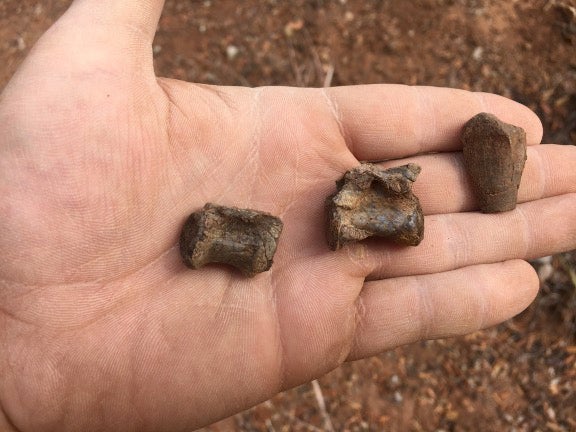Sauropods were dinosaurs that truly lived large. This group of long-necked, four-legged herbivores, such as the celebrated species Apatosaurus and Brachiosaurus, included the largest creatures to ever walk the planet. Some grew to more than 100 feet long and weighed more than 80 tons. Now paleontologists have uncovered one of the earliest members of this storied lineage of lumbering giants: a svelte, much smaller omnivore that once darted across the floodplains of prehistoric Zimbabwe.
The new dinosaur, described on Wednesday in Nature, is named Mbiresaurus raathi. The moniker references Mbire, the district of Zimbabwe where the fossil was found, and pays tribute to paleontologist Michael Raath, who first published on fossils from the area. The creature is the oldest dinosaur yet found in Africa, Yale University paleontologist Christopher Griffin and his colleagues report—and it represents the early days of a lineage that would come to include classic dinosaurs such as Diplodocus.
The dinosaur’s discovery came from an effort to understand how plants and animals were affected by climate change during the Triassic period, between 252 million and 201 million years ago. “Dinosaurs began to disperse across the globe during this time,” Griffin says, with the earliest dinosaur remains generally found at localities that would have been at the same latitude in Triassic South America and India. After Raath reported fossils of a similarly early age in Zimbabwe, paleontologists went looking for more—and got more than they anticipated. During one such expedition, Griffin recalls, he uncovered what turned out to be the left femur of a Mbiresaurus. “The femur is one of those distinctive bones that you can tell right away is from a dinosaur,” he says, “so once I dug that out, I knew I was holding the oldest definitive dinosaur ever found in Africa.”
On supporting science journalism
If you're enjoying this article, consider supporting our award-winning journalism by subscribing. By purchasing a subscription you are helping to ensure the future of impactful stories about the discoveries and ideas shaping our world today.
The newly found specimen, which was surprisingly complete for a very early dinosaur, belonged to a group called sauropodomorphs. This roughly 230-million-year-old Mbiresaurus is represented by a nearly complete skeleton, containing parts of the skull and spinal column and elements of both the front and hind legs. “We’re really only missing parts of the hands, an ankle bone and a few of the skull elements,” Griffin says.

Paleontologist Christopher Griffin holds tailbones and a limb end of Mbiresaurus. Credit: Christopher Griffin
The new dinosaur did not look anything like a miniature Apatosaurus, despite that giant being among its famous relatives. Mbiresaurus was only about five feet long, and it ran on two legs. All the same, telltale characteristics in the dinosaur’s bones more closely resemble those of sauropodomorphs than the traits found in other dinosaur groups.
Mbiresaurus lived at a time when the ancestors of the great sauropods were small, fleet-footed omnivores that had yet to make the switch to an all-vegetarian diet.
Evolutionary relationships among early dinosaurs can be a contentious topic in paleontology. A small dinosaur from Triassic Argentina named Eoraptor, for example, was originally categorized as a member of the theropods—a very early predecessor to dinosaurs like Tyrannosaurus rex—but was later found to be a sauropodomorph. “At about 230 million years ago dinosaurs had already diverged into their three major groups, but they were still very similar to each other” says paleontologist Diego Pol of the Paleontological Museum Egidio Feruglio in Argentina, who reviewed the new study for Nature but was not directly involved in the work. Still, Pol notes, Mbiresaurus “does look like a very primitive sauropodomorph, much like the relatives of the same age we know from South America.”
The world Mbiresaurus lived in was very different from Earth as we know it today. Much of the planet’s landmasses were locked up in the supercontinent Pangaea, and Zimbabwe was farther south and more distant from any ocean than it is now. Many of the animals the dinosaur lived alongside were quite different, too, from weasel-like protomammals called cynodonts to armadillo-like crocodile relatives called aetosaurs. The local habitat would have been a semiarid place, with ferns, horsetails and conifers growing along streams and lakes—sediment from which eventually buried Mbiresaurus and its neighbors.
And dinosaurs couldn’t roam wherever they pleased during this time. Placing Mbiresaurus into the broader pattern of how dinosaurs originated and spread around the world, Griffin and his co-authors arrived at a scenario that suggests there were strong climate barriers around the prehistoric equator. These hot zones temporarily prevented dinosaurs from moving across Earth’s midline. Dinosaurs originated and started to diversify in Pangea’s southern parts and could only move northward when such barriers were reduced, leading to what Griffin and his colleagues propose were distinct phases of dinosaur dispersal around the world. “This gives us a glimpse of the dynamics of the Triassic world,” Pol says, when the Age of Reptiles had only just begun to take hold.